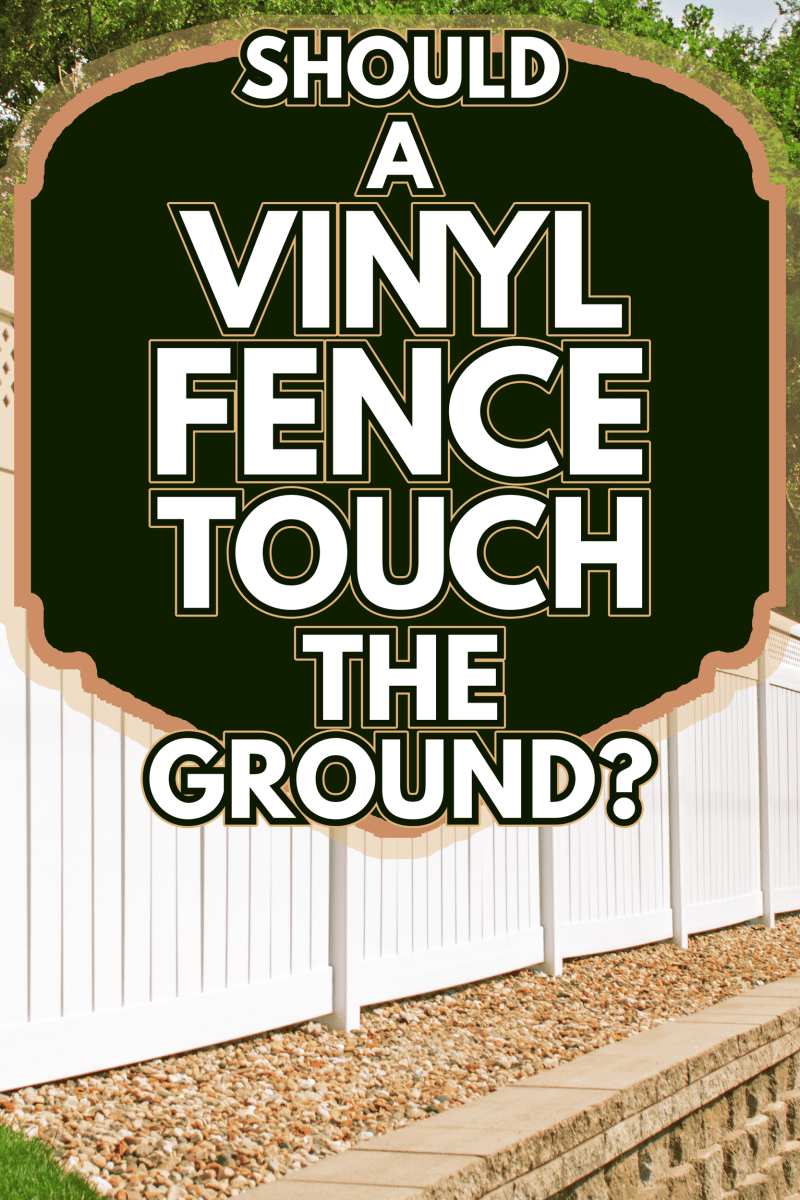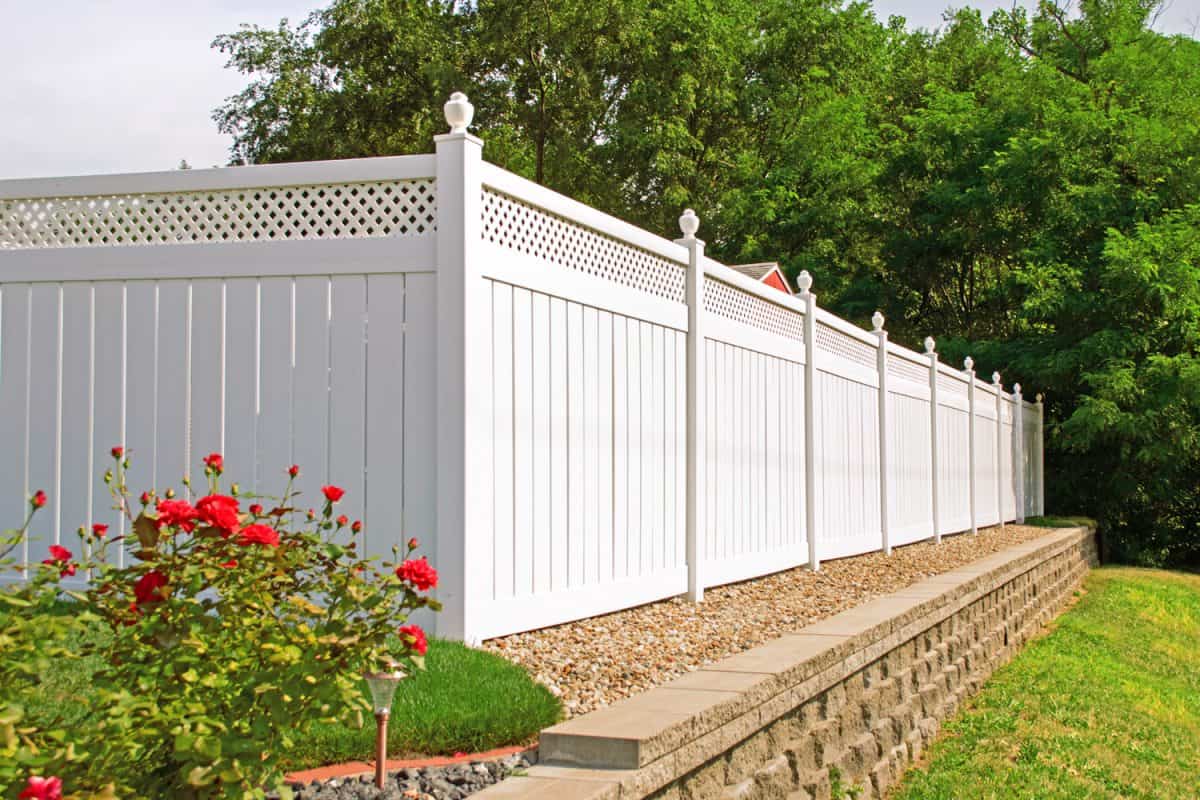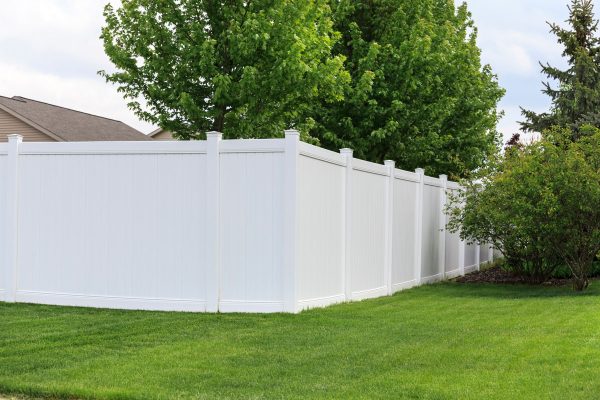As a homeowner, you might want to install a vinyl fence but don't know whether it is better to plant the bottom or keep it off the ground. Fortunately, we have consulted experts in this field, and here's their answer to this concern.
A vinyl fence should not be installed too close to the ground. This is because the fence could lose balance or fall under pressure. When it rains, panels near the ground can redirect rainwater and this might cause flooding. So, it is better to leave some space under the fence panels.
If a vinyl fence touches the ground, it could deteriorate quickly. Continue reading to get detailed information about vinyl fencing.

Why A Vinyl Fence Should Never Touch The Ground

Mistakes made during the vinyl fence installation are similar to the ones made when installing other fence types. It is recommended to install a fence with care and seek help if needed.
Most homeowners have discovered that wood fences rot quickly if the fence panel comes in contact with the ground. So, they turn to vinyl fencing because they believe this type will not rot and it does not need to be set above the ground. But, there is actually a problem if your vinyl fence touches the ground.
If your vinyl fence touches the ground it can get moldy, so you should install it above the ground. Also, your vinyl fence may not be able to resist the pressure of snow load during winter.
Fences touching the ground have a high chance of heaving with frost. It is better to install your fences at least two inches above ground level. Vinyl fences are not very durable when installed on the ground. They tend to deteriorate faster.

How Do I Fill The Gap Between My Fence And The Ground?
Vinyl fencing has many benefits, but going all the way to the ground isn't the best. Since it has one standard height, there may be a gap between your fence and the ground, especially in uneven areas of your yard.
Even though you install your vinyl fence on flat ground, there will still be gaps. The following are ways to deal with the gap between your fence and the ground:
Stepped Fence Installation
Stepping is one of the methods used to install a vinyl fence in an uneven yard. This method involves arranging the fence in a way that it will be even with the ground as you line it up along the slope. For a better look, try lowering the fence at a similar rate with every panel.
When using this technique, there is usually a small gap between the surface and the base of the fence. But the gap stops increasing as you make more progress. The good thing about this method is that more materials aren't needed, so you don't need to spend extra.
Rock Filler Technique
You can also fill the gaps underneath your vinyl fence with rocks and small stones. You can arrange the stone on the ground before setting the vinyl panels. Alternatively, use the stones to fill the gaps after installing the fence.
Barrier Method
This is another option, you can set a barrier of any kind to the bottom of the fence. If you are using this method, you should position the fence in such a way that each part is even at the top. After that, you can lock each piece of vinyl to the base of the fence, filling up all the gaps.
Dirt or Mound Technique
Just as the name implies, you have to cover the gaps underneath the fence with dirt. When doing this, make sure to pack the dirt tightly into the gap.
It is better to use this method if you want to fill the gap because of its looks. With this method, you can easily remove the mounds of dirt whenever you want to take down your fence.
How Deep Should Vinyl Fence Posts Be?

It is better to use 30 inches for PVC fence posts. Anything below 30 inches depends on some factors including installation specs and manufacturer design. Postholes are capable of holding 1/3 of your post's length and an extra six inches for the gravel base.
How Far Apart Should Vinyl Fence Posts Be Arranged?
The spacing between the post should be about 93-½ inches for an 8-foot section. If you are installing the fence on a slope, the distance may be shorter. This greatly depends on the slope. You can use a rail as a spacer between the posts.
It is better to pound your post 48 inches into the ground. To achieve an appropriate post spacing, you should measure the length of your bottom rail, adding 1/4 inches.
https://www.istockphoto.com/photo/vinyl-fence-gm175545195-21351793
Does Vinyl Fence Hold Up Wind?
Powerful wind cannot pull down a vinyl privacy fence if it has good support and is properly installed. A vinyl fence is capable of holding up against winds of even 100 mph.
When installing vinyl picket fencing, make sure the fence posts are 3-½ inches square or more but shouldn't be more than 5 inches square. The ideal wall thickness is .160 inches so they can withstand high wind.
Are Vinyl Fences Worth It?
You should consider using viny fences. They are alternatives to traditional materials like wood and metals. Vinyl fences are durable and need low maintenance. If you are conscious of the environment, choosing vinyl saves trees that will be cut and used for wooden fences.
Mistakes When Installing Vinyl Fences

Vinyl fence is important in our homes. It provides privacy and keeps pets and children safe inside your home while adding aesthetic quality to your home. Here are some things that need to be avoided when installing a vinyl fence:
- Poor post setting: When building a vinyl fence, always insert the post deep into the ground.
- Leaving excess space in-between: Vinyl offers good privacy, but the sections should be near each other.
- Stress and buckling: A vinyl fence is more likely to buckle from stress. You need to place posts not exceeding one foot away from each other.
- Hammering: You are not supposed to force the vinyl fence into the ground. This may bend or break. Make sure to dig a hole, then secure it by backfilling it with the ground.
- Wrong fence installation: It is essential to always go through guides and product manuals. For instance, it is better to set your vinyl fence post no less than 3 feet into the ground. This prevents shifts. Always remember to measure the angle of the grade. If you don't consider these when installing vinyl fences, your fence may not last long.
Conclusion
Vinyl fences are a popular option for homeowners who want to keep their yards and homes looking neat and well-maintained. However, vinyl fences should not touch the ground.
It is easy to keep a vinyl fence in good condition. When installing the fence, make sure it is above the ground so it won't get moldy easily. That vinyl fence hardly rot doesn't mean they should be on the ground.
If you enjoyed reading this post, here are similar articles you may like:
What Type Of Privacy Fence Lasts The Longest?

![A modern middle class home with its backyard being enclosed for privacy by a new, modern style white vinyl fence. Green grass, and blue sky is in the background., Can Vinyl Fencing Withstand Wind? [Plus 7 Windproofing Tips!]](https://fencefixation.com/wp-content/uploads/2022/06/A-modern-middle-class-home-with-its-backyard-being-enclosed-for-privacy-by-a-new-modern-style-white-vinyl-fence.-Green-grass-and-blue-sky-is-in-the-background-600x400.jpg)
![A white vinyl fence running across a yard on spring day with blue sky and trees in the background, Can Vinyl Fence Touch The Ground? [Plus Tips On How To Close The Gap]](https://fencefixation.com/wp-content/uploads/2022/06/A-white-vinyl-fence-running-across-a-yard-on-spring-day-with-blue-sky-and-trees-in-the-background-600x400.jpg)
